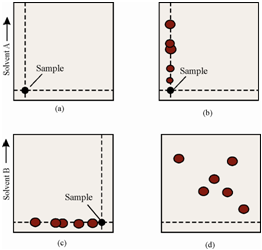Identification of gallic acid:
In a typical case, presence of gallic acid in trifala (a mixture of Harad, Baheda and Amla) was identified by thin layer chromatography in ethyl acetate-methanol (7:3) solvent system. A standard sample of gallic acid was spotted along side of unknown and compared as shown in Figure. It is observed that the two samples give spots with Rf = 0.86. Presence of gallic acid was further confirmed by elemental analysis, infrared, NMR and GC-MS methods.

Figure: Identification of gallic acid in trifala using ethyl acetate - methanol (7:3) solvent system where comparable Rf values are observed
Similar to the two-dimensional paper chromatography described in sub-Sec. 6.2.5 and Figure, the two-dimensional thin layer chromatography has been found to be very effective for the separation of complex mixtures. The sample is spotted in one corner and developed with the first solvent. After thorough drying, a plate is turned by 90o and developed along with the second solvent. The whole procedure of the development of chromatogram is display in Figure. It can be compared along with a 'standard map' of known mixtures.

Fig.: Schematic representation of two-dimensional thin layer chromatography; (a) sample is spotted in one corner, (b) results obtained after first separation, (c) rotation of plate by 90º and (d) final chromatogram